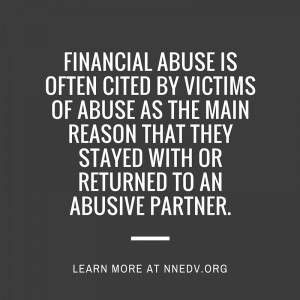Financial Abuse and Empowerment
Financial abuse is a common tactic used by abusers to gain power and control in a relationship. The forms of financial abuse may be subtle or overt but in in general, include tactics to conceal information, limit the victim’s access to assets, or reduce accessibility to the family finances. Financial abuse – along with emotional, physical, and sexual abuse – includes behaviors to intentionally manipulate, intimidate, and threaten the victim in order to entrap that person in the relationship. In some cases, financial abuse is present throughout the relationship and in other cases financial abuse becomes present when the survivor is attempting to leave or has left the relationship.
Financial abuse, while less commonly understood, is one of the most powerful methods of keeping a survivor trapped in an abusive relationship and deeply diminishes the victim’s ability to stay safe after leaving an abusive partner. Research indicates that financial abuse occurs in 99% of domestic violence cases. Surveys of survivors reflect that concerns over their ability to provide financially for themselves and their children was one of the top reason for staying in or returning to an abusive partner. As with all forms of abuse, financial abuse occurs across all socio-economic, educational, and racial and ethnic groups.
Forms of Financial Abuse
As with other forms of abuse, financial abuse may begin subtly and progress over time. It may even look like love initially as abusers have the capacity to appear very charming and are masterful at manipulation. For example, the abuser may make statements such as, “I know you’re under a lot of stress right now so why don’t you just let me take care of the finances and I’ll give you money each week to take care of what you need.” Under these circumstances, the victim may believe that she or he should or can trust the partner she or he is in love with and may willingly give over control of the money and how it is spent. This scenario commonly leads to the abuser giving the victim less and less in “allowance” and by the time the victim decides she or he wants to take back control of the finances, she or he discovers that the accounts have all been moved or she or he no longer has knowledge or access to the family funds.
In other cases, the financial abuse may be much more overt. Abusers commonly use violence or threats of violence and intimidation to keep the victim from working or having access to the family funds.
Whether subtle or overt, there are common methods that abusers use to gain financial control over their partner. These include:
- Forbidding the victim to work.
- Sabotaging work or employment opportunities by stalking or harassing the victim at the workplace or causing the victim to lose her/his job by physically battering prior to important meetings or interviews.
- Forbidding the victim from attending job training or advancement opportunities.
- Controlling how all of the money is spent.
- Not including the victim in investment or banking decisions.
- Not allowing the victim access to bank accounts.
- Withholding money or giving “an allowance.”
- Forcing the victim to write bad checks or file fraudulent tax returns.
- Running up large amounts of debt on joint accounts.
- Refusing to work or contribute to the family income.
- Withholding funds for the victim or children to obtain basic needs such as food and medicine.
- Hiding assets.
- Stealing the victim’s identity, property, or inheritance.
- Forcing the victim to work in a family business without pay.
- Refusing to pay bills and ruining the victims’ credit score.
- Forcing the victim to turn over public benefits or threatening to turn the victim in for “cheating or misusing benefits.”
- Filing false insurance claims.
- Refusing to pay or evading child support or manipulating the divorce process by drawing it out by hiding or not disclosing assets.
The Impact of Financial Abuse
The short- and long-term effects of financial abuse can be devastating. In the short-term, access to assets is imperative to staying safe. Without assets, survivors are often unable to obtain safe and affordable housing or the funds to provide for themselves or their children. With realistic fears of homelessness, it is little wonder that survivors sometimes return to an abusive partner.
For those who manage to escape the abuse and survive initially, they often face overwhelming odds in obtaining long-term security and safety. Ruined credit scores, sporadic employment histories, and legal issues caused by the abuse make it extremely difficult to gain independence, safety, and long-term security.







